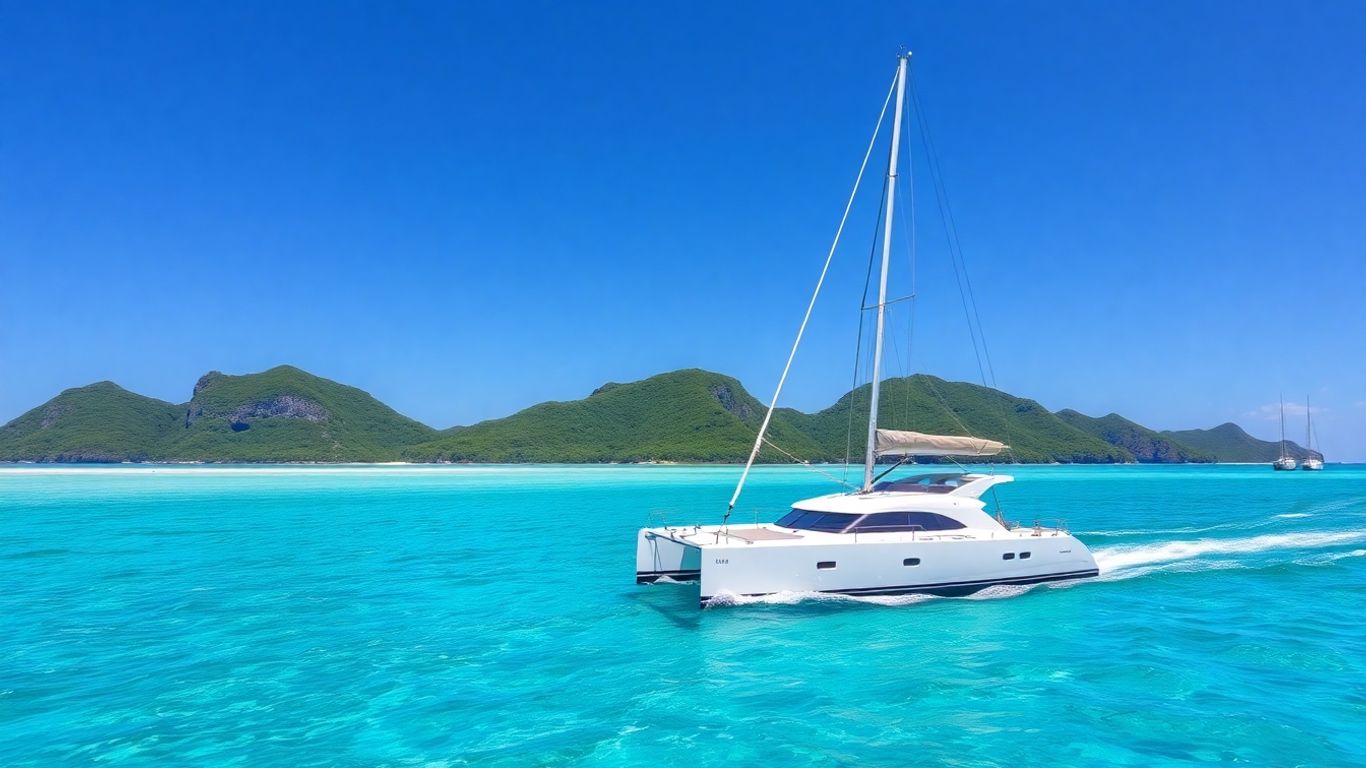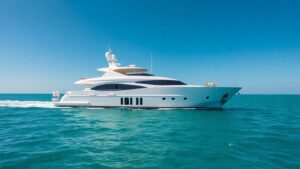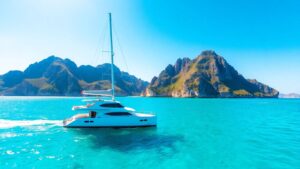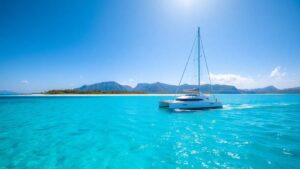Thinking about a trip to the U.S. Virgin Islands? Renting a catamaran is a fantastic way to see everything. It gives you so much freedom to explore the islands at your own pace. Whether you want to find quiet coves or visit popular spots, a catamaran charter can make it happen. This guide will walk you through how to pick the right boat, when to go, where to visit, and what to expect.
Key Takeaways
- Choosing the right catamaran virgin islands rental depends on your group size and desired experience, with options ranging from bareboat to fully crewed.
- The best time to rent a catamaran in the USVI is generally from mid-December to late April to avoid hurricane season and enjoy steady winds.
- Popular destinations for your catamaran virgin islands rental include the natural beauty of St. John, the famous bays of St. Thomas, and the relaxed vibe of Coral Bay.
- All-inclusive catamaran virgin islands rental packages often include gourmet meals, a professional crew, and onboard comforts for a stress-free vacation.
- When planning your catamaran virgin islands rental, remember to check local rules, be mindful of marine life, and pack smart for island hopping.
Choosing Your Ideal Catamaran Virgin Islands Rental
So, you’re thinking about a catamaran trip in the US Virgin Islands. That’s awesome! But before you start picturing yourself sailing off into the sunset, you need to figure out what kind of rental works best for you. It’s not a one-size-fits-all deal, and picking the right setup makes a huge difference in your vacation.
Understanding Different Charter Types
When you look into renting a catamaran, you’ll see a few main ways to do it. Think about what kind of trip you want. Are you looking for total freedom to steer your own ship, or do you want someone else to handle all the work? The USVI offers a bunch of options, from just the boat itself to a fully staffed floating hotel. It really comes down to how much you want to be involved in the sailing and how much you want to just kick back and be taken care of.
Bareboat vs. Skippered Charters
This is a big one. If you’ve got sailing experience and your own certifications, a bareboat charter might be your jam. You’re basically renting the boat and you’re the captain. This means you’re in charge of everything – where you go, when you stop, how you handle the boat. It’s great for feeling independent and exploring at your own speed. On the flip side, a skippered charter means you hire a captain to sail the boat for you. This is perfect if you want to relax and not worry about the sailing part, or if you’re not super confident handling a boat in new waters. The captain knows the islands like the back of their hand, so they can take you to all the best spots you might not find on your own.
The Luxury of Fully Crewed Catamarans
Now, if you’re really looking to go all out, a fully crewed catamaran is the way to go. This is like having your own private resort on the water. You get a professional captain, a chef, and usually a deckhand or mate. They handle all the sailing, cooking, cleaning, and pretty much anything else you need. The chef can whip up amazing meals based on your preferences, using fresh, local ingredients. The crew takes care of all the planning, so you can just enjoy the stunning scenery, swim in clear waters, and explore different bays without lifting a finger. It’s the ultimate stress-free vacation experience, where every detail is managed for your comfort and enjoyment.
Navigating the Best Times for a Catamaran Virgin Islands Rental
So, you’re thinking about a catamaran trip to the US Virgin Islands? That’s awesome! Picking the right time to go can make a big difference in your vacation. You want good weather, calm seas, and maybe to avoid the biggest crowds, right?
Optimal Sailing Seasons
Generally, the sweet spot for sailing in the USVI is from mid-December through April. During these months, the winds are usually pretty steady, around 15-20 knots, which is great for sailing. The weather is typically sunny with not much rain. It’s a popular time because the conditions are just right for hopping between islands like St. Thomas and St. John, finding quiet coves, and enjoying the clear blue water.
Avoiding Hurricane Season
Now, let’s talk about when to steer clear. Hurricane season officially runs from June 1st to November 30th. While not every year sees a direct hit, the risk is higher during this period. The weather can be unpredictable, with sudden storms and heavy rain. If you’re planning a trip during these months, it’s really important to keep a close eye on weather forecasts and have flexible plans. Many people prefer to book their charters outside of this window to have more peace of mind.
Understanding Seasonal Weather Patterns
Beyond hurricane season, the weather does change a bit throughout the year.
- Winter (December – April): This is the dry season with the most consistent trade winds. It’s also the busiest and often the most expensive time to visit.
- Spring (May – June): The weather is still great, with warm temperatures and less wind than winter. It’s a good shoulder season before the summer heat and potential for rain increases.
- Summer (July – November): This period is hotter and more humid. While you can still have fantastic sailing days, there’s a greater chance of afternoon showers and the aforementioned hurricane risk.
When planning your trip, consider what’s most important to you: the most reliable sailing winds, the lowest prices, or the quietest beaches. Each season has its own vibe and set of advantages.
It’s always a good idea to check the long-range weather outlook closer to your travel dates, no matter when you decide to go. Having a flexible mindset can help you make the most of whatever the weather brings.
Discovering Premier Destinations with Your Catamaran Virgin Islands Rental

When you charter a catamaran in the US Virgin Islands, you’re not just getting a boat; you’re unlocking a treasure chest of incredible islands and bays. Each island has its own vibe, from the lush, protected nature of St. John to the lively bays of St. Thomas. It’s all about picking the spots that call to you.
Exploring St. John's Natural Wonders
St. John is practically a national park, and for good reason. Most of the island is protected, meaning you get to see it as nature intended. Think crystal-clear waters perfect for a snorkel, and quiet coves where you can just drop anchor and chill. Waterlemon Cay is a must-see for anyone who loves looking at colorful fish and coral. You can also hike some old trails that show you a bit of the island’s history, like old sugar plantations. It’s a really peaceful place to spend a few days.
Experiencing St. Thomas's Iconic Bays
St. Thomas offers a different kind of beauty. Magens Bay is famous, and it’s easy to see why. It’s a big, calm bay with a long sandy beach, great for just floating around or trying out a paddleboard. You can also explore some smaller, wilder cays nearby, like Congo Cay or Carvel Rock, which have cool underwater spots for snorkeling. If you’re looking for a mix of beautiful scenery and places to relax, St. Thomas has you covered. You can even visit Buck Island, a protected area with lots of sea turtles and fish.
Uncovering Coral Bay's Charm
Coral Bay, on the east side of St. John, has a more laid-back, rustic feel. It’s less developed than other spots, which is part of its appeal. It’s a great place to anchor for the night and just enjoy the quiet. Sometimes you can find places ashore with live music, giving you a taste of local island life. It’s a good spot to just slow down and soak in the Caribbean atmosphere. If you’re looking for a truly authentic island experience, Coral Bay is worth checking out. You can find some great catamaran rentals in the Virgin Islands here for your trip.
Enhancing Your Experience: All-Inclusive Catamaran Virgin Islands Rental Perks
When you opt for an all-inclusive catamaran rental in the US Virgin Islands, you’re essentially signing up for a completely worry-free vacation. Think of it as having your own floating resort, where every detail is handled so you can just kick back and soak it all in. It really takes the stress out of planning, letting you focus on the fun parts of island hopping.
Gourmet Dining at Sea
Forget packing snacks or worrying about where to eat. With an all-inclusive charter, you get a private chef onboard. These chefs are usually quite skilled and can whip up amazing meals using fresh, local ingredients. Whether you’re craving some just-caught fish grilled to perfection or a fancy multi-course dinner, they can tailor the menu to your tastes. It’s a pretty sweet deal to have restaurant-quality food prepared right in front of you, with a stunning ocean view as your dining room.
Personalized Service from a Professional Crew
Part of the magic of an all-inclusive trip is the crew. You’ll typically have a captain who knows these waters like the back of their hand, guiding you to the best spots – maybe a quiet cove for swimming or a reef teeming with fish. Then there’s often a chef, and sometimes other crew members depending on the boat size, who are there to make your stay comfortable. They handle everything from preparing meals and drinks to tidying up and helping with water toys. Their goal is to make your trip as smooth and enjoyable as possible.
Onboard Luxury and Comfort
These catamarans aren’t just boats; they’re designed for comfort and relaxation. You’ll find spacious decks, plenty of room to spread out, and usually well-appointed cabins. Many charters come with amenities like kayaks, paddleboards, and snorkeling gear, giving you plenty to do right off the boat. It’s a great way to explore the islands at your own pace, enjoying the freedom of the open water without sacrificing comfort. You can really discover the Virgin Islands and Bahamas through an all-inclusive yacht charter experience.
The beauty of an all-inclusive package is that it bundles the cost of your yacht, crew, food, and drinks into one price. This makes budgeting much simpler and allows you to anticipate your vacation expenses more accurately. It’s a straightforward way to manage your holiday spending.
Essential Tips for Your Catamaran Virgin Islands Rental Adventure

So, you’re all set for a catamaran trip in the US Virgin Islands. That’s awesome! To make sure your time on the water is as smooth as possible, here are a few things to keep in mind. It’s not rocket science, but a little prep goes a long way.
Understanding Local Regulations and Permits
When you’re out on the water, it’s important to know the rules. Most charter companies will handle the big stuff, but it’s good to be aware. For instance, there are rules about where you can anchor, especially near protected areas or private property. Always check with your charter company about any specific permits needed for certain activities or if you plan to visit different islands. They’re usually in the know about what’s required.
Respecting Marine Life and Reefs
The USVI has some seriously beautiful coral reefs and marine life. It’s our job to keep it that way. Never touch or stand on coral reefs, as they are living organisms and very fragile. Use reef-safe sunscreen – the kind that doesn’t harm the coral. If you’re snorkeling or diving, keep a good distance from sea turtles, rays, and other creatures. Just observe and enjoy without disturbing them. It makes the experience better for everyone, including the animals.
Packing Essentials for Island Hopping
Packing smart means you’ll be ready for whatever the islands throw at you. Think light and quick-drying clothes. You’ll definitely want:
- Reef-safe sunscreen: Protect yourself and the ocean.
- A wide-brimmed hat and sunglasses: The sun can be intense.
- Water shoes or sandals with good grip: Handy for getting on and off the boat, especially if you’re exploring rocky spots.
- A light jacket or sweater: Evenings can sometimes get a bit breezy.
- Waterproof phone case: For those amazing underwater shots.
- A reusable water bottle: Stay hydrated and cut down on plastic.
Bringing cash is also a good idea for small purchases ashore or for tipping your crew if you’re happy with their service. While many places take cards, some smaller vendors or beach bars might be cash-only. Plus, tipping the crew is customary if they’ve made your trip special, usually around 15-20% of the charter cost.
Planning Your Catamaran Virgin Islands Rental Journey
Getting your catamaran adventure in the US Virgin Islands sorted out is all about a few key steps. It’s not super complicated, but thinking it through makes the whole trip way smoother.
Starting Your Sailing Holiday from St. Thomas
Most catamaran charters in the USVI kick off from St. Thomas. It’s the main hub, with a big airport (Cyril E. King Airport, STT) and lots of marinas. Think of it as the gateway. You’ll likely fly into St. Thomas and then head to your chosen marina to meet your boat and crew. It’s pretty convenient because you can get there from many places without too much hassle.
Getting to the US Virgin Islands
Reaching the islands is usually done by plane. Major airlines fly into St. Thomas (STT) and St. Croix (STX). If you’re coming from the mainland US, you generally won’t need a passport if you’re a US citizen, which is a nice perk. Flights can vary in price depending on when you book and where you’re flying from, so it’s good to look around.
Considering Charter Duration and Costs
When you’re thinking about how long to charter and what it’ll cost, there are a few things to keep in mind.
- Duration: Most people go for 7 to 10 days. This gives you enough time to really explore a few islands without feeling rushed. Shorter trips are possible, but you might feel like you’re just getting started when it’s time to leave.
- Costs: The price tag for a catamaran charter can really change based on a few things.
- Yacht Size and Type: Bigger boats or fancier models, like a Sunreef compared to a Lagoon, will cost more.
- Time of Year: Peak season (usually winter) is more expensive than the off-season.
- All-Inclusive vs. Bareboat: An all-inclusive charter covers food, drinks, and the crew, making it pricier upfront but often simpler. A bareboat charter means you’re responsible for everything, which can be cheaper if you’re good at provisioning and have sailing experience.
- Number of Guests: More people usually means a bigger boat, which adds to the cost.
Budgeting early helps a lot. Knowing your spending limit from the start makes it easier to narrow down your options and find a boat that fits your needs and your wallet. It really streamlines the whole booking process.
Here’s a rough idea of what might be included in different charter types:
| Charter Type | Included Typically |
|---|---|
| Bareboat | Yacht rental only |
| Skippered | Yacht rental, Captain |
| Fully Crewed | Yacht rental, Captain, Chef, Steward/Host, Meals, Drinks |
Remember, things like dockage fees, taxes, and sometimes fuel might be extra, even on all-inclusive trips. Always check what’s covered when you get your quote.
Your USVI Adventure Awaits
So, you’ve got the lowdown on making your US Virgin Islands trip happen with a catamaran. It’s all about picking the right boat, knowing when to go, and just letting loose. Whether you’re dreaming of quiet coves or lively beach bars, a catamaran charter really lets you see these islands your way. Think about those crystal-clear waters and warm breezes – it’s all within reach. Get ready to make some awesome memories out on the water.
Frequently Asked Questions
What's the best time of year to rent a catamaran in the US Virgin Islands?
The sweet spot for sailing in the US Virgin Islands is usually from the middle of December to the end of April. During this time, the winds are steady and pleasant, and there’s less rain. It’s best to avoid the hurricane season, which typically runs from June through November.
Do I need a special license to rent a catamaran in the USVI?
In many cases, you don’t need a sailing license to rent a boat in the USVI, especially if you choose a charter with a captain. However, if you plan to captain the boat yourself (a bareboat charter), you’ll likely need proof of sailing experience or a recognized sailing certification. It’s always best to check with your charter company.
What's the difference between a bareboat and a skippered charter?
A bareboat charter means you’re in charge of sailing the boat yourself. You’ll need to be an experienced sailor. A skippered charter includes a professional captain who will sail the boat for you, handle navigation, and often knows the best spots to visit. It’s a great option if you want to relax and not worry about sailing.
What does an all-inclusive catamaran rental include?
An all-inclusive rental typically covers everything for a stress-free trip! This usually means a captain and crew, all your meals and drinks, and sometimes even water toys. You just need to show up and enjoy your vacation.
What are some must-see places when sailing the US Virgin Islands?
You’ll definitely want to explore the stunning natural beauty of St. John, like Waterlemon Cay for amazing snorkeling. St. Thomas has famous spots like Magens Bay, perfect for relaxing. Don’t miss Coral Bay on St. John for its laid-back vibe and beautiful, less crowded waters.
How do I get to the US Virgin Islands to start my charter?
Most people fly into Cyril E. King Airport (STT) on St. Thomas. There are direct flights from several major cities in the U.S., or you can connect through San Juan, Puerto Rico. From the airport, you can easily get to the marinas by taxi or shuttle.



